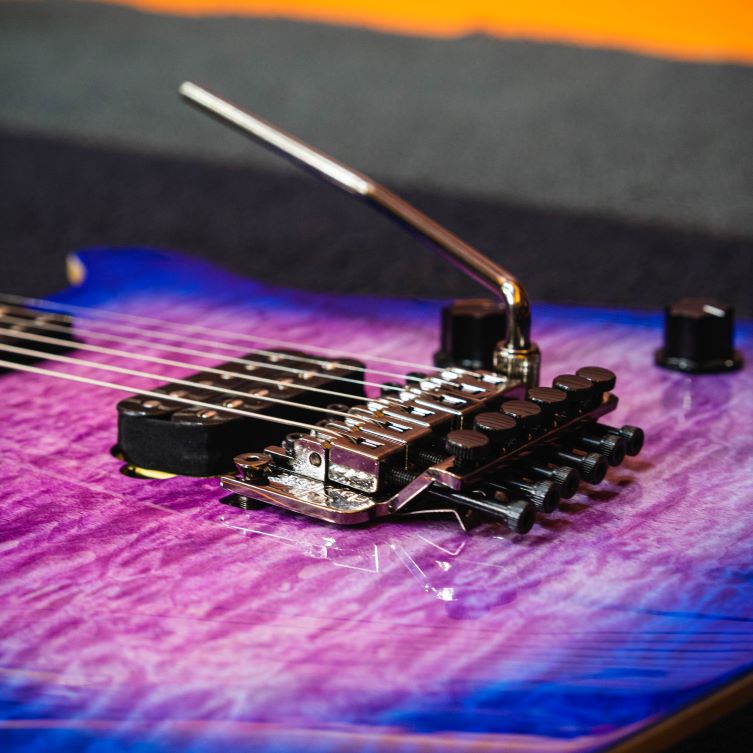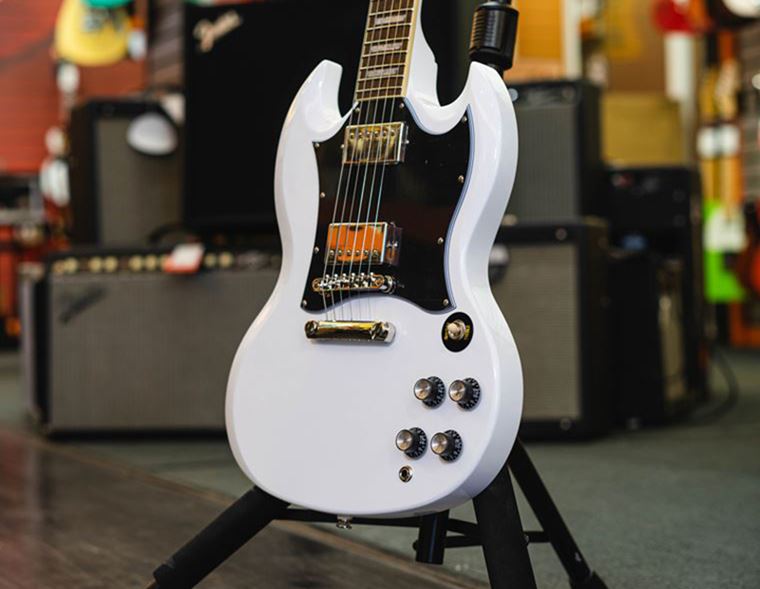How To: Floyd Rose Tips and Tricks
Published on 06 October 2022
Disclaimer: The information in this article is provided by the guest blogger and does not necessarily reflect the views and opinions of guitarguitar.
Most people who get a Floyd Rose tremolo do it with a purpose: they want to bend their notes as much as possible! While the person taking beginner guitar lessons would have a lot of fun with a Floyd Rose, it’s definitely more suited for the intermediate and advanced player. A guitar equipped with a more flexible bridge will allow a player to add completely new sounds into their repertoire.
Owning a Floyd Rose
The Floyd Rose is a system with a locking, floating bridge and a locking nut. This mechanism allows for more string movement as you bend the arm. The bridge can be moved so much that a guitar with bad action can run into problems when the strings touch the fretboard. A proper setup on a guitar is always essential, but especially with a guitar that has so much string movement.
When you tune a Floyd Rose, it is not like a regular guitar, you must pay close attention and keep it balanced. Start by tuning the low 6th and then the high 1st string, after that the 2nd and 5th are tuned, and we finish by tuning the 3rd and 4th. By starting on the outside and working our way in, we can avoid any issues that happen from uneven tension. Tuning and re-tuning each string several times is normal, so don’t worry about that! It’s all about achieving balance across all six strings.
Having a Floyd Rose tremolo is not for the set-it-and-forget-it types: extra care is needed when installing and tuning. The springs in the back of the guitar that help counterbalance the movement can also cause noise interference, so some players use tissue or felt to help dampen those sounds. If you have a very noisy guitar, this spring muting will likely help the problem.
Regular maintenance for this specialised tremolo can be a bit nuanced and tedious. For example, a straightforward task such as changing strings takes a few more steps than a normal guitar. Don’t lose the locking nut plates! The locking nut plates are designed to face a particular way, as well. If you are noticing any string slipping, take another look at the locking nut plates and ensure they are facing the correct way. Cleaning the Floyd Rose mechanisms can be a bit tedious as well. More dust, sweat and gunk can get stuck within the machinery of the Floyd Rose than a typical tremolo. This can cause rust and corrosion more quickly over time. You can use a can of compressed air to clear the gears, or a simple wipedown after each use should do the trick.
When bending strings this much, issues will arise, but they are a small price to pay for the wails and squeals that are now possible to play. Once it is equipped correctly you will have the power to perform crazy pitch changes and insane vibrato. Here are some of the effects that you can achieve.
If you’re interested in learning about how the tremolo came into existence, check out guitarguitar’s article What is a Floyd Rose?

Tips, Tricks, and Techniques on the Floyd Rose Tremolo
Vibrato
The easiest technique is the simple vibrato of shaking the bar back and forth. How hard it is pushed and pulled will change the intensity of the sound. You don’t always have to insanely warp the strings, and a light shake is sometimes all that’s necessary. It will sound a little like a car engine with a slow low pressure pull on a low note. And while the vibrato is easy to make, remember it must fit and sound musically pleasing, this will take practice.
Sometimes you can play just one note and move the bar back and forth, getting a decent range of sounds. But it’s even better when you play trills or arpeggios and then add in vibrato bar movement. A simple 3 note riff or some barre chords while pushing and pulling the bar will sound awesome.
The Dive Bomb
The dive bomb was made popular by Eddie Van Halen and is the defining sound of the Floyd Rose. It is created by hitting a note and then pushing the bar until the tension brings the note to a stop. That is just the basic method, wiggling the bar on the way down will provide a vibrato dive. The way the note is played will also change the final sound, often a harmonic is played on an open string before depressing the bar for a dramatic, high-pitched dive.
A reverse dive bomb starts by pushing the bar in and then hitting a note before pulling the bar back out. And these can both be done in forward and reverse repeatedly for a very powerful effect.
Tapped Harmonics
Often Floyd Rose effects are done with harmonics like the divebomb, so it is important to perfect your harmonic playing to get the most out of the tremolo. Practice by tapping your harmonics out at every node, and while tapping pull the bar. This harmonic pitch being raised with the tremolo arm can sound gritty or be played clean to almost sound like a singing bird!
The Flutter
The flutter is achieved by flipping the tremolo arm very quickly, which creates a quick fluttering vibe. It doesn’t take much, just a quick little flick can give you a cool sound. Be sure to flip it in the direction the bar is aimed to get the proper effect. You can do the flutter after hitting a note or mixed in with other effects like at the end of a divebomb.
If you give the bar a quick flip right at the start of the note, instead of after, you will get something like a flutter known as a hiccup. Whether you are fluttering the note at the end or beginning it’s all about giving the bar a quick hit at just the right moment.
The Warble
If we lightly rest our hand on the bridge and give it a shake while playing it can cause a warbly and warped effect. It really stands out when we pick an arpeggio and do this light palm movement. It provides a sound that is like damaged analog tape, which is ok in light doses. Be careful though as you do not want too much hand movement against the bridge, or you will mess up the fine tuners.
The Squeal
Dimebag Darrel was best known for his squeals on a Floyd Rose. To create the effect, bend the string down with your middle finger as far as possible so it plays as you let go. At the same time use your ring finger to play a harmonic as you bring the bar up, this will create a squeal. The harder you pull the bar, the greater the squeal, to the point of nearly being a siren. Be sure to mute any strings not being played so they do not interfere with it.
The Lizard Down the Throat
This effect works best on the middle strings like the G or B, and we start about midway down the neck. Your fretting fingers will play one or more notes by pulling downward in a very deep bend. As the string bends we start moving towards the nut, but at the same time we are pulling the bar up. The more synchronous the action, the more the pitch will stay stable, but at the same time creating a deep garbled sound. Joe Satriani was one of the notable users of this effect. This technique was invented by Joe Satriani.
Conclusion
Many of these tricks can be mixed and played with to create a variety of wails, screams, and squeals. Instead of just pushing or pulling you can move it fast in a circle motion for a shriller sound. Just remember when trying out the different techniques to be mindful of where the tremolo arm is and how you are moving it. There is an art to playing a whammy bar just right, it takes as much practice as your fretting, tapping, and other guitar skills.
These are just the basic moves you will use when you play with a Floyd Rose Tremolo, of course there is a world of sound experimenting possible. Not only does it allow for large pitch changes and great vibrato, but it also gives you a chance for more expression in your guitar playing. And most of all music fans love to hear the crazy effects you can get with a double locking bridge!
Author: Shawn Ledonhardt
Bio: Shawn is an author for Guitar Tricks and 30 Day Singer, the original platform for online guitar lessons.











